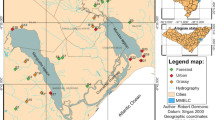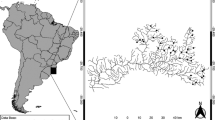Abstract
We compared the fish assemblage structure from streams with different intensities of physical habitat degradation and chemical water pollution by domestic sewage in southeastern Brazil. Eight streams (R1–R8) showing less disturbed or more disturbed conditions of chemical water quality and of physical habitat quality were selected. Cumulative abundance and biomass, combined in ABC plots, revealed (i) biomass curves above the abundance curves, represented by the streams R1–R2 (water and habitat less disturbed) and R5–R6 (water more disturbed and habitat less disturbed), and (ii) biomass curves below the abundance curves, represented by the streams R3–R4 (water less disturbed and habitat more disturbed) and R7–R8 (water and habitat more disturbed). The quantitative structure of the ichthyofauna showed significant correspondence with physical habitat condition but not with chemical water quality. The most significant species to cause the dissimilarity between less disturbed and more disturbed physical habitats was the exotic Poecilia reticulata. Such results indicate that in the focused region—with little influence of industrial pollution, noncritical domestic sewage discharge, and soil predominantly used for pasture—streams with high physical habitat integrity possess a differently structured ichthyofauna than streams with relatively low physical habitat integrity, reinforcing the importance of the physical habitat quality and riparian conservation along these water courses, warranting the conservation of these systems. Indeed, our results also reinforce the importance of including biotic descriptors, particularly of the ichthyo-fauna, in water-monitoring programs designed to reveal signs of human interference.


Similar content being viewed by others
References
Allan J. D., A. S. Flecker. 1993. Biodiversity conservation in running waters. BioScience 43:32–43
Angermeier P. L. 1985. Spatio-temporal patterns of foraging success for fishes in an Illinois stream. The American Midland Naturalist 114:342–359
Angermeier P. L., J. R. Karr. 1983. Fish communities along environmental gradients in a system of tropical streams. Environmental Biology of Fishes 9:117–135
Barbour M. T., J. Gerritsen, B. D. Snyder, J. B. Stribling. 1999. Rapid bioassessment protocols for use in streams and wadeable rivers: periphyton, benthic macroinvertebrates and fish, 2nd edition. EPA 841-B-99-002. U. S. Environmental Protection Agency; Office of Water, Washington, DC
Bond N. R., P. S. Lake. 2003. Characterizing fish-habitat associations in streams as the first step in ecological restoration. Austral Ecology 28:611–621
Casatti L. 2004. Ichthyofauna of two streams (silted and reference) in the upper Paraná River basin, southeastern Brazil. Brazilian Journal of Biology 64:757–765
Casatti L., F. Langeani, A. M. Silva, R. M. C. Castro. 2006. Stream fishes, water and habitat quality in a pasture dominated basin, southeastern Brazil. Brazilian Journal of Biology 66:29–41
Castro R. M. C., L. Casatti. 1997. The fish fauna from a small forest stream of the upper Paraná River Basin, southeastern Brazil. Ichthyological Explorations of Freshwaters 7:337–352
Castro R. M. C., L. Casatti, H. F. Santos, K. M. Ferreira, A. C. Ribeiro, R. C. Benine, G. Z. P. Dardis, A. L. A. Melo, R. Stopiglia, T. X. Abreu, F. A. Bockmann, M. Carvalho, F. Z. Gibran, F. C. T. Lima. 2003. Estrutura e composição da ictiofauna de riachos do Rio Paranapanema, sudeste do Brasil. Biota Neotropica 3: http://www.biotaneotropica.org.br/v3n1/pt/abstract?article+BN01703012003
Castro R. M. C., L. Casatti, H. F. Santos, A. L. A. Melo, L. S. F. Martins, K. M. Ferreira, F. Z. Gibran, R. C. Benine, M. Carvalho, A. C. Ribeiro, T. X. Abreu, F. A. Bockmann, G. Z. Pelição, R. Stopiglia, F. Langeani. 2004. Estrutura e composição da ictiofauna de riachos da bacia do Rio Grande no Estado de São Paulo, sudeste do Brasil. Biota Neotropica 4: http://www.biotaneotropica.org.br/v4n1/pt/abstract?article+BN01704012004
CETESB (Companhia de Tecnologia e Saneamento Ambiental). 2003. Relatório de qualidade de águas interiores do Estado de São Paulo 2002. Secretaria do Meio Ambiente, São Paulo, 273 pp
Clarke K. R., R. M. Warwick. 1994. Change in marine communities: an approach to statistical analysis and interpretation. Plymouth Marine Laboratory, Plymouth, UK, 144 pp
Clarke K. R., R. N. Gorley. 2001. PRIMER v5: User manual/tutorial. PRIMER-E, Plymouth, UK
Dale V. H., S. C. Beyeler. 2001. Challenges in the development and use of ecological indicators. Ecological Indicators 1:3–10
DelValls T. A., M. Conradi, E. Garcia-Adiego, J. M. Forja, A. Gómez-Parra. 1998. Analysis of macrobenthic community structure in relation to different environmental sources of contamination in two littoral ecosystems from the Gulf of Cádiz (SW Spain). Hydrobiologia 385:59–70
Eklöv A. G., L. A. Greenberg, C. Brönmark, P. Larsson, O. Berglund. 1998. Response of stream fish to improved water quality: a comparison between the 1960s and 1990s. Freshwater Biology 40:771–782
Fausch K. D., J. Lyons, J. R. Karr, P. L. Angermeier. 1990. Fish communities as indicators of environmental degradation. American Fisheries Society Symposium 8:123–144
Gerhard P., R. Moraes, S. Molander. 2004. Stream fish communities and their associations to habitat variables in a rain forest reserve in southeastern Brazil. Environmental Biology of Fishes 71:321–340
Gorman O. T., J. R. Karr. 1978. Habitat structure and stream fish communities. Ecology 59:507–515
Hall L. W. Jr., R. P. Morgan, E. S. Perry, A. Waltz. 1999. Development of a provisional physical habitat index for Maryland freshwater streams. Maryland Department of Natural Resources, Monitoring and Non-tidal Assessment Division, Annapolis
Karr J. R., E. W. Chu. 1999. Restoring life in running waters. Island Press, Washington D.C., 206 pp
Hearn W. E., B. E. Kynard. 1986. Habitat utilization and behavioral interaction of juvenile Atlantic salmon (Salmo solar) and rainbow trout (S. gairdneri) in tributaries of the White River, Vermont. Canadian Journal of Fisheries and Aquatic Sciences 43:1988–1998
Karr J. R., K. D. Fausch, P. L. Angermeier, P. R. Yant, I. J. Schlosser. 1986. Assessing biological integrity in running waters, a method and its rationale. Natural History Survey, Special Publication 5, Urbana, USA, 28 pp
Kasyak P.F. 2001. Maryland biological stream survey: sampling manual. Maryland Department of Natural Resources, Monitoring and Non-tidal Assessment Division, Annapolis, Maryland
Kennard M. J., A. H. Arthington, B. J. Pusey, B. D. Harch. 2005. Are alien fish a reliable indicator of river health? Freshwater Biology 50:174–193
Magurran A. E. 2004. Measuring biological diversity. Blackwell Publishing, Oxford, 256 pp
Martin-Smith K. M. 1998. Relationships between fishes and habitat in rainforest streams in Sabah, Malaysia. Journal of Fish Biology 52:458–482
Mazzoni R., N. Fenerich-Verani, E. P. Caramaschi. 2000. Electrofishing as a sampling technique for coastal stream fish populations and communities in the Southeast of Brazil. Brazilian Journal of Biology 60:205–216
Meffe G. K., A. L. Sheldon. 1988. The influence of habitat structure on fish assemblage composition in southeastern blackwater streams. The American Midland Naturalist 120:225–240
Mendonça F. P., W. E. Magnusson, J. A. Zuanon. 2005. Relationships between habitat characteristics and fish assemblages in small streams of central Amazonia. Copeia 2005:751–764
Millard C. J., P. F. Kazyak, D. M. Boward. 1999. Lower Susquehanna Basin: environmental assessment of stream conditions. Maryland Department of Natural Resources. Monitoring and Non-tidal Assessment Division, Annapolis, Maryland
Minchin P. R. 1987. An evaluation of the relative robustness of techniques for ecological ordination. Vegetatio 69:89–107
Reyes-Gavilán F. G., R. Garrido, A. G. Nicieza, M. M. Toledo, F. Braña. 1996. Fish community variation along physical gradients in short streams of northern Spain and the disruptive effect of dams. Hydrobiologia 321:155–163
Reznick D. N., H. Bryga. 1987. Life-history evolution in guppies (Poecilia reticulata): 1. Phenotypic and genetic changes in an introduction experiment. Evolution 41:1370–1385
Roth N. E., J. D. Allan, D. L. Erickson. 1996. Landscape influences on stream biotic integrity assessed at multiple spatial scales. Landscape Ecology 11:141–156
Roth N. E., M. T. Southerland, G. Mercurio, J. H. Volstad. 2001. Maryland biological stream survey 2000–2004: Ecological assessment of watersheds sampled in 2000. Prepared by Versar Inc. for the Maryland Department of Natural Resources, Monitoring and Non-Tidal Assessment Division, Annapolis, Maryland, CNWP-MANTA-EA-01-5
Shibatta O. A., C. C. Cheida. 2003. Composição em tamanho dos peixes (Actinopterygii, Teleostei) de ribeirões da bacia do Rio Tibagi, Paraná, Brasil. Revista Brasileira de Zoologia 20:469–473
Trexler J. C. 1988. Phenotypic plasticity in poeciliid life histories. Pages 201–214 in G. K. Meffe and Englewood Cliffs, N. F. F. Snelson (eds.), Ecology and evolution of livebearing fishes (Poeciliidae). Prentice Hall, Englewood Cliffs, NJ
Warwick R. M. 1986. A new method for detecting pollution effects on marine macrobenthic communities. Marine Biology 92:557–562
Wichert G. A., D. J. Rapport. 1998. Fish community structure as a measure of degradation and rehabilitation of riparian systems in an agricultural drainage basin. Environmental Management 22:425–443
Acknowledgments
We thank colleagues from the Laboratório de Ictiologia IBILCE-UNESP for their help during field work; Daniela M. L. Silva for useful information about physicochemical parameters of water; Pedro Gerhard, Denise C. Rossa-Feres, Mary Daniels, Virginia H. Dale, Frank H. McCormick, Rosana Mazzoni, and anonymous reviewers for helpful suggestions on the manuscript; Departamento de Zoologia e Botânica IBILCE-UNESP for facilities; IBAMA for collecting license (001/2003); and landowners for permission to conduct research on their properties. This study was made possible by funding from the “BIOTA/FAPESP–The Virtual Biodiversity Institute Program” (http://www.biota.org/br) of the Fundação de Amparo à Pesquisa do Estado de São Paulo (01/13340-7, 02/05996-2, 03/02753-4, 03/02766-9, 03/02767-5, 03/12893-8, 03/09612-7).
Author information
Authors and Affiliations
Corresponding author
Rights and permissions
About this article
Cite this article
Casatti, L., Langeani, F. & Ferreira, C.P. Effects of Physical Habitat Degradation on the Stream Fish Assemblage Structure in a Pasture Region. Environmental Management 38, 974–982 (2006). https://doi.org/10.1007/s00267-005-0212-4
Received:
Accepted:
Published:
Issue Date:
DOI: https://doi.org/10.1007/s00267-005-0212-4




